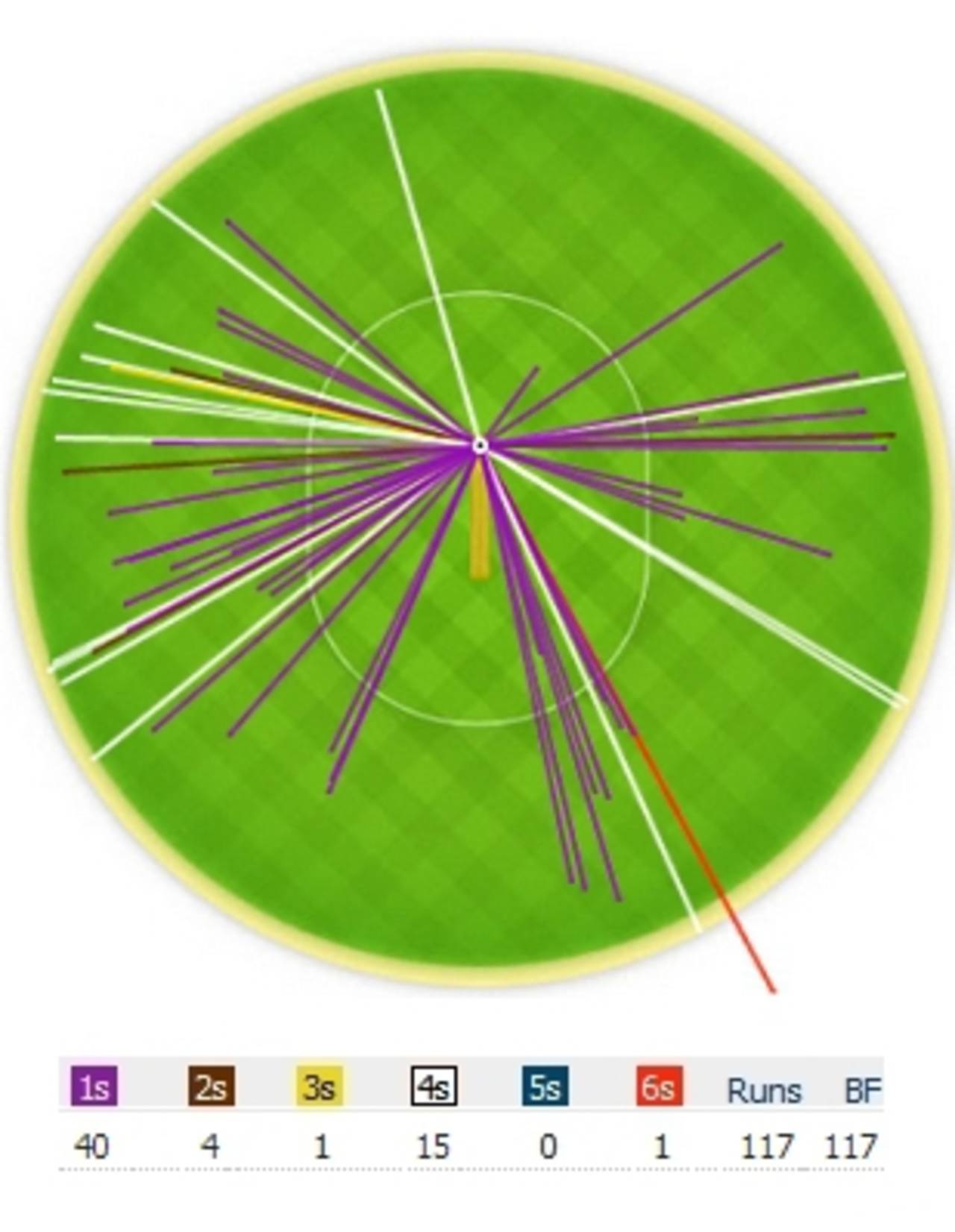Discipline, Sehwag style
There will be those who will still pick holes in Virender Sehwag's opening-day hundred, but he could not have done much more to make up for a two-year century drought and set the tone for the series
Sidharth Monga
15-Nov-2012

The wagon wheel of Virender Sehwag's innings shows how he exploited the area behind backward point • ESPNcricinfo Ltd
There are two sides to this Virender Sehwag century, his first since November 2010, which was incidentally scored at the same venue. The one obvious aspect, which will leave doubters unsatisfied, revealed itself in the first over of the match when a short-of-a-length ball bounced knee high and a length ball was met alongside the shin. Then again, sometimes Sehwag does not do himself any favours by making certain kinds of pitches look much easier than they actually are.
The other aspect of the innings was its impact, which actually surfaced with the control England could exert after he got out. Sehwag scored 117 off 117, the rest managed 206 off 424. While Sehwag was at the wicket, England looked almost helpless and India went at close to 4.5 an over. After Sehwag, England became part of action too, and India crawled at under 2.5 an over for the rest of the day.
This was a slow and low pitch difficult to take wickets on - definitely not one where spinners can hit batsmen in the ribs - but it was also a pitch difficult to score fast on. India would need all the time and scoreboard pressure to take wickets here, and it is Sehwag who has provided them that without even stretching himself.
It was not just about the pitch, it was also the first morning of a big series against a side that had not long ago whitewashed India. England's best chance was against the openers who have both been through extended dry runs. One opener was coming in without a century in nearly two years, the other in nearly three. Their last century partnership came in 2010 in Centurion. At the same time, India needed to take immediate control. And when you need immediate control - in certain conditions, it must be added - you dial for Sehwag.
And it's slightly simplistic to scoff at the conditions. Agreed there was no bounce, pace or sideways movement on offer in the morning session, but these conditions are difficult to dominate in once the fielding side sits back and intends to cut down the runs. England went for just that as soon as they realised there was nothing in it for their quicks. Mid-off and cover went back, and just one slip and gully remained.
It had the desired effect on Gautam Gambhir, who became edgy and tried to manufacture cuts and punches off Graeme Swann, finally falling to one such shot. And Sehwag? He seemed to be batting on a flat track with true bounce where it seemed all he had to do was plant the front foot down and play his shots. And he did so without going out of his way. If you hadn't seen the scoreboard, you would have thought this was old-fashioned Test batting where he was looking to see the new ball off. He glided more than carved, steered more than smashed, and yet brought up his sixth century at more than a run a ball, now behind only Adam Gilchrist among batsmen to do so since 1990.
There was this one time in the first session when he had moved forward to a shortish delivery from Tim Bresnan. The ball stayed low, and yet somehow he managed to - even while moving forward - punch it wide of mid-on for four. The look of disbelief on England faces clearly suggested they should be getting wickets off those balls, not going for fours.
Then there were the shots where he compensated for lack of room with the open face and the wrists behind the shots. Two overs before that punch for four, he received one near yorker from Bresnan, on middle and off, and without even backing away he managed to create his own room by opening the face and unfurling the wrists behind it.
The other feature of the innings was his shot selection. He didn't go slashing after everything, nor did he leave the crease even once against the spinners. Too often when it becomes, or looks easy, he tries adventure, almost as if fighting boredom. Today it was all determination. He batted like a batsman should after two years without a century. Don't go by his strike-rate; it misleads. This was an innings of discipline, of opportunistic discipline.
There were quite a few overs in the morning session when the bowlers would bowl accurately to him, giving him neither driving length nor cutting room. And he would block and block and block, only to pounce on the first sight of width. Stuart Broad discovered that before lunch after an over full of shortish deliveries that shaped back in. And when he provided slight width with the last ball, he was cut away for four.
There will still be those - and they won't be unjustified - who will point to the conditions when they talk of this innings, but it should also be noted that accumulating in these conditions is one thing, and quite another to boss them. And Sehwag deserves his due credit for bossing here.
Sidharth Monga is an assistant editor at ESPNcricinfo